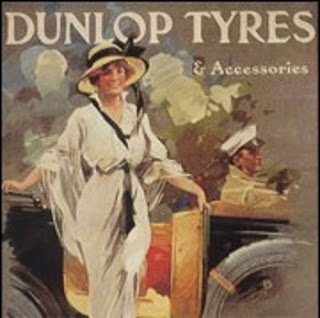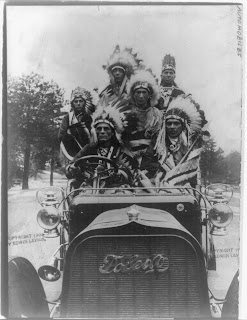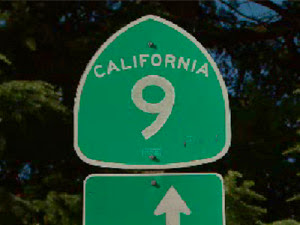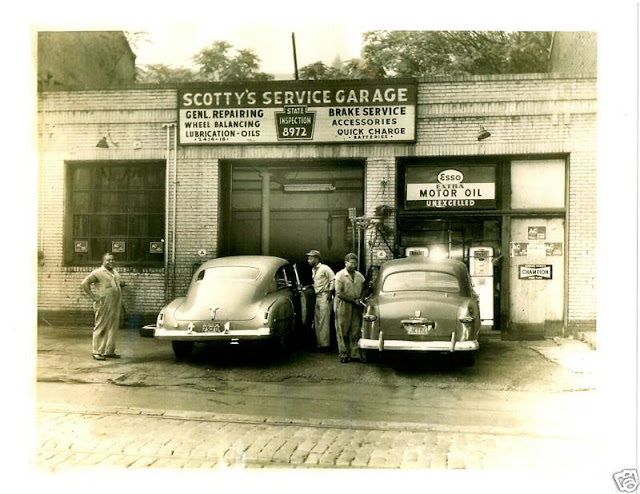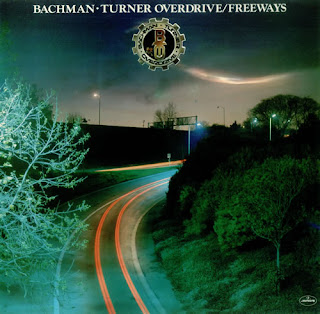Technological Antecedents – The Bicycle
Concurrent
to ICE technological advances were developments related to the bicycle that
took place in America
between 1880 and 1900. The bicycle created a widespread demand for flexible,
personal transportation, and it brought freedom to both women and young people.
While the nineteenth century railroads exposed Americans to rapid (for the day)
land transport, the very fact that tracks limited transverse spatial mobility
opened the door to possibilities for more adaptable movement on roadways.
Bicycles, despite their shortcomings associated with muscle power, difficult
terrain, and weather, put urban dwellers in motion. In particular, their
introduction and diffusion raised important questions concerning the quality of
roads, manufacturing techniques, social changes, and legislation. Without
exaggeration, the bicycle set the stage for the automobile that followed.
The bicycle
story began in Europe around 1819 with the
introduction of a hobbyhorse design. Its historical evolution is traced in
David Herlihy’s beautifully illustrated monograph.9 The first
mechanical bicycle is credited to the Scotsman Kirkpatrick MacMillian, who in
1839 constructed a home-built, treadle-driven device so that he could more
easily visit his sister who lived some 40 miles away. This invention was for
the most part ignored until the 1860s, when in France so-called pedal velocipedes
were manufactured by carriage maker Pierre Michaux and his son Ernest. These
designs were a cross between the modern bicycle and the wooden hobbyhorse. The
velocipede’s wheels consisted of wooden spokes and rims held together by a
steel band. The front wheel was larger than the rear, and pedals were attached
directly to the axle. With ivory handlebar grips, and a seat resembling an
animal’s spine, this awkward-looking device weighed sixty pounds. It quickly
earned itself an appropriate nickname – “the bone-shaker” – as it traversed the
rough roads of that era. In 1869 the velocipede made its way to American
shores, where a number of American firms improved its design. An American
version incorporated hollow instead of solid steel tubes, and a self-acting
brake. To stop, the rider pushed against the handlebars, thus compressing the
seat spring and causing a brake shoe to engage against the rear wheel. It was seat-of-the-pants
driving at its best, more a curiosity and sport than everyday technology.
A brief
velocipede craze followed in the late 1860s. At the same time, several social
clubs were organized. It was difficult to ride the velocipede on the bumpy roads
of the day, and one had to walk it uphill. But after 1871 interest in this
less-than-practical device waned, in part because so many of the machines built
were poorly designed. A radically new design was needed, and that would come as
a result of the efforts of Englishman James Starley, who, to this day the
British honor as the father of the bicycle industry.
In 1870
Starley introduced his Ariel bicycle. Like its predecessors, the Ariel featured
front drive pedals. However, for greater efficiency Starley made the front
wheel as large as it could be, limited only by the length of the rider’s legs,
and thus increased the wheel circumference and relative efficiency.
Correspondingly, the rear wheel was reduced in size, making it just large
enough to maintain balance. Thus, the era of the bone-shaker had ended and that
of the “high wheeler” or “ordinary” began.
English
production techniques soon incorporated steel tubes, ball bearings, and solid
rubber tires. One riding a high-wheeler could reach 20 mph, but it was
dangerous and there was always the possibility of the rider “talking a header,”
and flying over the handlebars. It was awkward and precarious, but in Britain a wide
following soon emerged as clubs of cyclists were formed.
The
American ordinary craze was fueled by the efforts of manufacturer Colonel
Albert A. Pope, a Civil War veteran from Boston
who traveled to England ,
began importing British models, took the lead in establishing the American
League of Wheel Men in 1880 and built his own models under the Columbia trademark. By 1884, Pope’s firm made
some 5,000 “Columbia” units, and the technological gap between the U.S. and the
British narrowed.10 The inherent problem with the ordinary, however,
was that its size was connected with the stature of its rider, and thus
standardization was impossible. Therefore, economies of scale in manufacturing
could not be truly achieved.
The greatest advantage of British
bicycle manufacturers during the 1880s lay in superior metallurgical
techniques. Birmingham’s W.C. Stiff (an appropriate name given the technology
he developed!) perfected a method of weld-less tube manufacture that permitted
the brazing of light tubing to solid forging. By limiting the use of heavy
gauge metal to stress points, a considerably lighter bicycle could be made
without any loss of strength. Throughout the 1880s, American manufacturers were
forced to use English tubes if they aspired to build first-class products. The
British also modified the ordinary’s design by introducing gearing in the front
of the vehicle, thus allowing the rider to pedal easier. These geared bicycles
were called Dwarfs or Kangaroos, but most bicyclists saw them as no safer than
the conventional design. If safety was an issue, and it certainly was for many
women, they moved to a tricycle. American designers also attempted to reverse
the large and small wheels of the ordinary, putting the large wheel in the back
and gearing it, thus reducing the possibility of a rider going over the
handlebars due to a sudden stop or maneuver.
Americans
made valuable technical contributions to bicycle design, particularly during
the 1880s and 1890s. Just as the Americans seemed to be taking a lead in
bicycle technology, in the mid-1880s John Kemp Starley, nephew of the creator
of the Ariel, came up with the concept of the safety bicycle. This design
featured a triangular frame, two wheels of about 2 feet in diameter, and a rear
wheel driven by a sprocket connected to a chain. While the idea was not totally
new, it was the industrial commitment to this design that was so important.
Indeed, what emerged was the notion that safety was important, so much so that
high wheelers became market curiosities by 1890.
The social
impact of the safety bicycle was enormous, particularly after 1888 when the
design was coupled with John Boyd Dunlop’s pneumatic tires. The cycling
population expanded greatly, and women, who had shunned the earlier models,
embraced the dropped frame safety bicycle design. The dropped frame was
introduced in 1888, and shortly thereafter women bicyclists’ skirts were
shortened and their ankles exposed. Women began wearing bloomers, leading
Elizabeth Cady Stanton to remark, “Many a woman is riding to the suffrage on a
bicycle.”11 Further, young men and women could now go for rides
without third party supervision. Patriarchal and matriarchal controls were
increasingly being challenged by a machine, and as machines would become more
complex with the coming of the automobile, so would the resulting social
changes.
Sales
leaped forward in the 1890s, and an acetylene flame lamp was introduced in 1895
so that cyclist could travel safely at twilight and in the dark. For several
years during the trend-driven Gay 90s, bicycling became a full-fledged boom.
Bicycle racing became a popular sport, and many colleges established bicycling
teams. Further, the bicycle inspired sheet music, trading cards, and board
games. Undoubtedly the most famous of all songs inspired by the bicycle was
Harry Dacre’s “Daisy Bell,” composed in 1892 with its chorus:
Daisy Daisy,
Give me your answer do!
I'm half crazy,
All for the love of you!
It won't be a stylish marriage,
I can't afford a carriage,
But you'll look sweet on the seat
Of a bicycle built for two!12
Give me your answer do!
I'm half crazy,
All for the love of you!
It won't be a stylish marriage,
I can't afford a carriage,
But you'll look sweet on the seat
Of a bicycle built for two!12
By 1900,
some 300 firms made more than a million bicycles in the U.S., making it a world
leader. Innovations that followed included the coaster brake, a springed fork
in the front, and cushioned tires. The cost of the bicycle halved from $100 to
$50 during the 1890s, and thus American industry liberated the bicycle from its
status as a plaything for wealthy sportsmen to a far more popular tool for
travel. In doing so, the bicycle literally paved the way for the automobile,
including the innovations of Henry Ford that would follow in the first decade
of the twentieth century.
Apart from
raising consciousness concerning flexible travel and its impact on road
improvements in the United States, no preceding technological innovation – not
even the internal combustion engine – was as important to the development of
the automobile as the bicycle. The bicycle was the object of scorn by horsemen
and teamsters long before the appearance of the horseless carriage. Further,
bicyclists gained the legislative right to use public roads in Massachusetts as
early as 1879. Key elements of automotive technology that were first employed
in the bicycle industry and then subsequently made their way into early
automobiles included steel-tube framing, ball bearings, chain drive, and
differential gearing. The bicycle industry also developed the techniques of
quantity production using specialized machine tools, sheet metal, stamping, and
electric resistance welding that would become essential elements in the volume
production of motor vehicles.
An
innovation of particular note is the pneumatic bicycle tire, invented by Dr.
John B. Dunlop in Ireland in 1888.13 Dunlop was far from working in
a vacuum, however, as numerous inventors patented similar designs during the
late 1880s and early 1890s. Also, the rubber tire had a long history that
Dunlop undoubtedly built upon. Solid rubber tires were first introduced around
1835, and in 1845 Robert William Thompson, a civil engineer from Middlesex,
England, patented a pneumatic tire similar to Dunlop’s design. An important
issue was how to keep the tire on the rim, and it was not until the early part
of the twentieth century before a system employing a wire-reinforced bead was
widely adopted. Bicycle tires were the basis of automobile tires in France by
1895 and in the United States in 1896 when the B. F. Goodrich Company
scaled up a single-tube bicycle tire for one of Alexander Winton’s early
vehicles.
The
greatest contribution of the bicycle, however, was that it provided its owner
with the ability to go when and where one wanted to. Sunday trips to
out-of-the-way scenic places were now within the reach of the common man and
his family. As one commentator of the period poignantly remarked, “Walking is
on its last legs.”14 Thus, the bike was the first freedom machine,
as it remains to this day for younger children who want to travel beyond the
pale of an observing and controlling parent. It demanded, however, muscle power
and a willingness to be exposed to the weather. To this day in many European
cities the bicycle is an environmentally-friendly alternative to the
automobile.15









